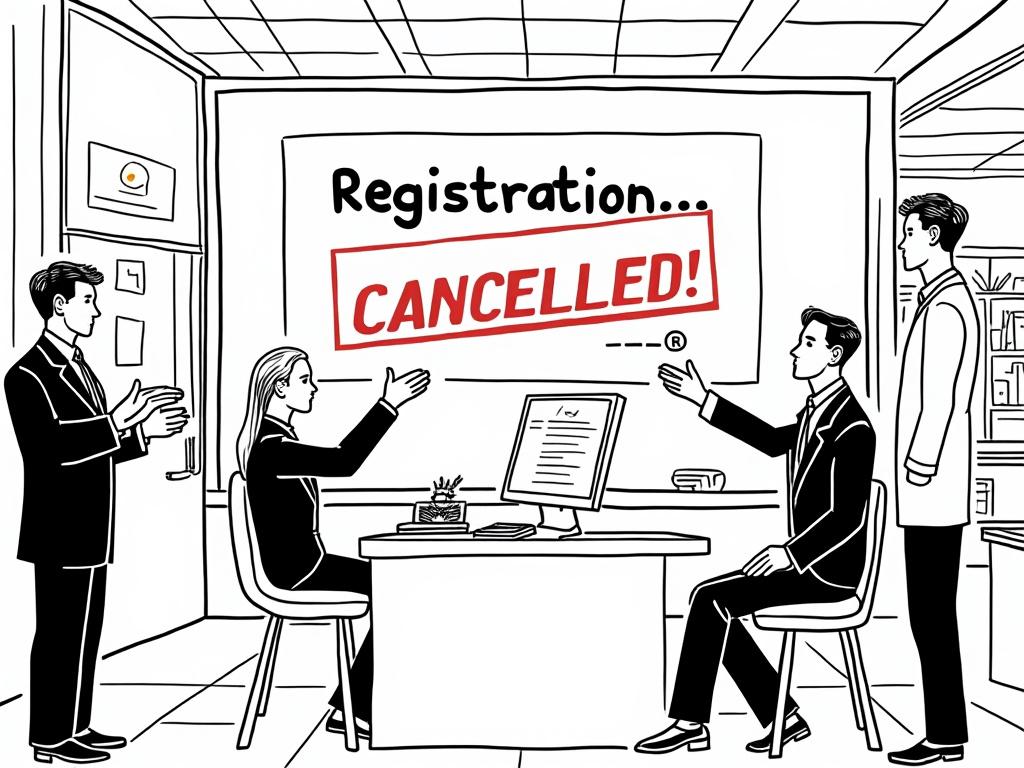
How to Cancel Your Business Registration: A Complete Exit Strategy Guide
Reading time: 12 minutes
Table of Contents
- Understanding the Cancellation Process
- Strategic Preparation Before Cancellation
- Step-by-Step Cancellation Process
- Navigating Common Challenges
- Financial and Legal Implications
- Post-Cancellation Considerations
- Frequently Asked Questions
- Your Strategic Exit Roadmap
Understanding the Cancellation Process
Closing a business isn’t just about turning off the lights and walking away. Whether you’re pivoting to a new venture, retiring, or facing financial challenges, **canceling your business registration requires strategic planning** to protect your interests and avoid future complications.
Here’s the reality: According to the U.S. Bureau of Labor Statistics, approximately 20% of small businesses fail within their first year, and about 65% close within 10 years. Yet surprisingly, many entrepreneurs don’t properly dissolve their business entities, leading to ongoing tax obligations and potential legal issues.
Business registration cancellation involves formally dissolving your legal entity with government authorities, settling obligations, and protecting yourself from future liabilities. The process varies significantly depending on your business structure, location, and specific circumstances.
Why Proper Cancellation Matters
Consider this scenario: Sarah ran a consulting LLC in California for three years before moving to Europe for a new opportunity. She simply stopped operating but never formally dissolved the business. Two years later, she received a $2,000 tax bill from the California Franchise Tax Board, plus penalties and interest.
**Key reasons for proper cancellation include:**
– Avoiding ongoing tax obligations and fees
– Protecting personal assets from business liabilities
– Maintaining clean credit and legal standing
– Preventing identity theft and fraudulent use of your business name
– Ensuring proper closure for tax purposes
Types of Business Structures and Cancellation Requirements
| Business Type | Cancellation Complexity | Average Timeline | Key Requirements | Estimated Cost |
|---|---|---|---|---|
| Sole Proprietorship | Low | 1-4 weeks | Cancel licenses, file final tax return | $0-$200 |
| LLC | Medium | 2-8 weeks | Member consent, state filing, tax clearance | $50-$500 |
| Corporation | High | 3-12 weeks | Board resolution, shareholder approval, asset distribution | $200-$2,000 |
| Partnership | Medium | 2-6 weeks | Partner agreement review, final distributions | $100-$800 |
Strategic Preparation Before Cancellation
Smart entrepreneurs approach business cancellation like any other business decision—with careful planning and strategic thinking. The preparation phase often determines whether your exit will be smooth or problematic.
Timing Your Cancellation
**The 90-day rule:** Most business advisors recommend starting the cancellation process at least 90 days before your intended closure date. This buffer allows time for unexpected complications, creditor notifications, and proper wind-down activities.
Consider timing factors such as:
– Tax year implications (filing final returns)
– Employee notification requirements (WARN Act compliance for larger businesses)
– Lease termination clauses and penalties
– Seasonal business considerations
– Outstanding contracts and commitments
Financial Health Assessment
Before initiating cancellation, conduct a thorough financial analysis. This isn’t just about checking your bank balance—it’s about understanding your complete financial picture.
**Essential financial checkpoints:**
– Outstanding debts and creditor obligations
– Accounts receivable and collection procedures
– Asset valuation and distribution plans
– Tax liabilities and potential refunds
– Employee compensation and benefits obligations
– Insurance claims and coverage termination
Step-by-Step Cancellation Process
Now let’s dive into the practical mechanics of business cancellation. While specific requirements vary by jurisdiction and business type, this framework applies to most situations.
Phase 1: Documentation and Legal Compliance
**Step 1: Review Corporate Documents**
Start by gathering all foundational documents—articles of incorporation, operating agreements, partnership agreements, and bylaws. These documents often contain specific dissolution procedures that must be followed.
**Step 2: Obtain Necessary Approvals**
– **Corporations:** Board of directors resolution and shareholder approval
– **LLCs:** Member consent (check operating agreement for voting requirements)
– **Partnerships:** Partner agreement review and consent
– **Sole Proprietorships:** Owner decision (no formal approval needed)
**Step 3: File Dissolution Documents**
Submit the appropriate dissolution or cancellation forms to your state’s Secretary of State office. Common forms include:
– Articles of Dissolution (Corporations)
– Certificate of Cancellation (LLCs)
– Statement of Dissolution (Partnerships)
Phase 2: Financial and Tax Obligations
**Tax Clearance Process:**
Most states require tax clearance before approving dissolution. This involves:
– Filing all required tax returns
– Paying outstanding tax liabilities
– Obtaining tax clearance certificates
– Notifying the IRS of business closure (Form 966 for corporations)
Business Dissolution Timeline Visualization
30-45 days
14-21 days
21-35 days
15-30 days
Phase 3: License and Permit Cancellation
Don’t overlook this critical step. Outstanding licenses and permits can continue generating fees and obligations even after business closure.
**Common licenses requiring cancellation:**
– Business operation licenses
– Professional licenses
– Sales tax permits
– Employer identification numbers
– Industry-specific permits (food service, construction, etc.)
– Federal licenses (if applicable)
Navigating Common Challenges
Even well-planned cancellations encounter obstacles. Here are the most frequent challenges and strategic solutions.
Challenge 1: Outstanding Debts and Creditor Issues
**The Reality Check:** You can’t simply dissolve a business to escape debts. Creditors have legal rights, and improper handling can lead to personal liability.
**Strategic Solutions:**
– Negotiate payment plans or settlements before dissolution
– Consider formal debt resolution procedures
– Maintain detailed records of all creditor communications
– Understand the difference between recourse and non-recourse debts
**Case Study:** Mike’s restaurant faced closure due to declining revenue. Instead of simply shuttering, he negotiated with major creditors, settled equipment loans for 60 cents on the dollar, and properly dissolved the LLC. This approach protected his personal assets and preserved his credit rating for future ventures.
Challenge 2: Employee Obligations and WARN Act Compliance
Businesses with 100+ employees must comply with the Worker Adjustment and Retraining Notification (WARN) Act, requiring 60 days’ advance notice of mass layoffs or closures.
**Best Practices:**
– Provide written notice to employees, union representatives, and local government
– Calculate all final compensation, including accrued vacation and benefits
– Understand state-specific requirements (some states have additional notice requirements)
– Consider offering outplacement services to maintain goodwill
Challenge 3: Asset Distribution Complications
Properly distributing business assets requires careful attention to legal priorities and tax implications.
**Distribution Priority Order:**
1. Secured creditors
2. Unsecured creditors
3. Owners/shareholders (remaining assets)
**Tax Implications:** Asset distributions often trigger tax consequences for both the business and recipients. Consult with tax professionals to minimize unexpected liabilities.
Financial and Legal Implications
Understanding the financial ramifications of business cancellation helps you make informed decisions and avoid costly mistakes.
Tax Considerations
**Federal Tax Obligations:**
– File final tax returns by the due date
– Report any cancellation of debt income
– Handle depreciation recapture on business assets
– Consider installment sale treatment for asset sales
**State and Local Tax Issues:**
– Obtain tax clearance certificates
– File final sales tax returns
– Address property tax obligations
– Handle business personal property tax
Personal Liability Concerns
Business cancellation doesn’t automatically eliminate personal guarantees or potential liability issues. Key considerations include:
– **Fraudulent transfer laws:** Distributing assets to avoid creditors can result in personal liability
– **Director and officer liability:** Corporate directors may face personal liability for certain decisions
– **Successor liability:** Some obligations may transfer to business successors
Post-Cancellation Considerations
Your responsibilities don’t end when the state approves your dissolution. Proper post-cancellation management protects your interests and sets the stage for future opportunities.
Record Retention Requirements
**Essential Documents to Preserve:**
– Tax returns and supporting documentation (7+ years)
– Employment records (varies by jurisdiction)
– Corporate records and dissolution documents
– Insurance policies and claims documentation
– Contracts and legal agreements
Future Business Opportunities
Proper business cancellation preserves your ability to start new ventures. Consider:
– **Name reservation:** You may want to reserve your business name for future use
– **Credit implications:** Proper closure protects your business and personal credit
– **Regulatory standing:** Clean dissolution maintains good standing with regulatory bodies
Frequently Asked Questions
Can I restart my business after cancellation using the same name?
Generally yes, but it depends on your state’s laws and whether someone else has claimed the name. You’ll need to file new registration documents and cannot simply “reactivate” the old business. If you think you might restart, consider reserving the business name during the cancellation process. This typically costs $10-50 and provides 60-120 days of name protection while you decide your next steps.
What happens if I discover debts or obligations after cancellation?
Post-dissolution obligations can still create liability, especially if proper creditor notification procedures weren’t followed. Most states have “claims periods” (typically 3-5 years) during which creditors can pursue claims against dissolved businesses. If significant obligations surface, you may need to consider formal reinstatement and proper dissolution procedures. This is why thorough pre-cancellation planning is crucial.
Do I need professional help to cancel my business registration?
While simple sole proprietorships often can be handled independently, most other business structures benefit from professional guidance. Consider professional help if you have significant assets, complex debt structures, multiple owners, employees, or operate in regulated industries. The cost of professional assistance (typically $500-2,500) often prevents more expensive problems later. At minimum, consult with a tax professional about the timing and implications of closure.
Your Strategic Exit Roadmap
Congratulations—you now have a comprehensive understanding of business cancellation procedures. But knowledge without action remains theoretical. Here’s your practical roadmap for implementing these strategies:
**Immediate Actions (Next 7 Days):**
– Conduct a complete financial health assessment
– Gather all corporate documents and review dissolution requirements
– Create a timeline for your specific situation
– Begin preliminary discussions with key stakeholders (partners, major creditors)
**Short-term Implementation (Next 30 Days):**
– Obtain necessary approvals from owners/partners/shareholders
– File required dissolution documents with state authorities
– Begin the tax clearance process
– Notify employees, customers, and vendors of closure timeline
**Final Execution (30-90 Days):**
– Complete asset distribution and debt settlement
– Cancel all licenses, permits, and registrations
– File final tax returns and obtain clearance certificates
– Establish proper record retention systems
**Long-term Protection (Ongoing):**
– Monitor for any post-dissolution issues or claims
– Maintain required records for statutory periods
– Consider name reservation if future restart is possible
The business landscape continues evolving, with remote work and digital businesses changing traditional closure considerations. Whether you’re closing due to market conditions, personal circumstances, or strategic pivots, proper dissolution protects your interests and preserves future opportunities.
Remember: Business cancellation isn’t failure—it’s strategic decision-making. Many successful entrepreneurs close multiple businesses throughout their careers, each closure providing valuable lessons and positioning them for future success.
Are you ready to turn your business closure into a strategic advantage that positions you for whatever comes next?

